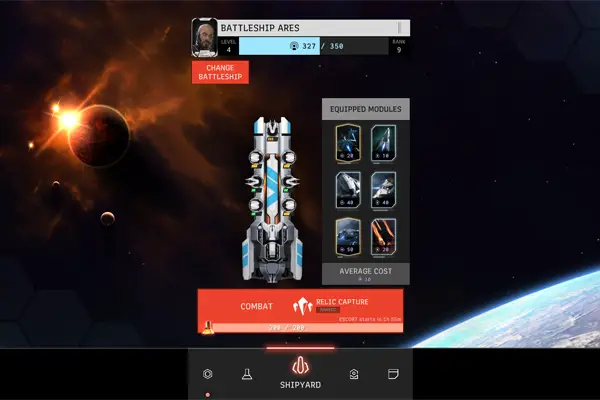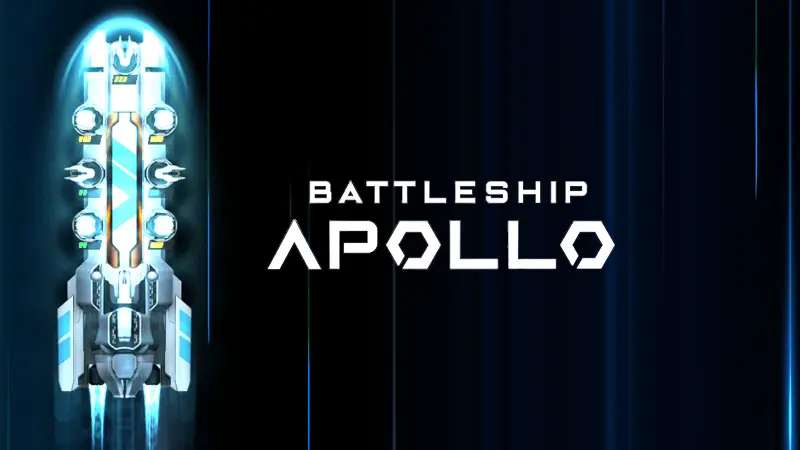Interstellar Leaderboards
Developed by Parallel Space, Battleship Apollo brings real-time tactics to the universe of its popular space strategy MMO Hades’ Star. This time around, Parallel Space goes for a much smaller scope, focusing on battles between single fleets rather than interplanetary empires.
Battleship Apollo takes place in the fictional Hades galaxy two hundred years after the events of Hade’s Star. In the centuries since the galaxy’s colonization, powerful megacorporations have risen to battle for supremacy. Interstellar warfare revolves around enormous hyper-advanced Battleships. Said ships boast a range of devastating weapons and can construct entire fleets mid-battle. Players take the role of the various cybernetically augmented Battleship Commanders and can form or join Corporations to battle for dominance.
That’s it as far as story or world-building goes. There are no campaigns, challenge modes, or even territory control mechanics for the Corporations. Players advance on individual and Corporation leaderboards, but that’s it. One vs. one PVP battles are the core of Battleship Apollo and the game isn’t for you if you’re not into that.

Space Command
Credit where it’s due, the game’s tactical battles are fun with a fair bit of mechanical complexity. Combat takes place on a hexagonal grid, with three waypoints in each hex. Battleships are restricted to movement between these predefined points, though their AI-controlled escorts can move freely across the field of battle. Battleship turrets fire in an arc depending on their stats and the position on the ship’s hull. A wise Commander will try to maximize the number of overlapping fields of fire while minimizing blind spots in their defenses.
There are nine different classes of Battleship with varying configurations of turrets. Some, like the Kronos, have an overlapping field of fire in the front but are vulnerable from behind. Other Battleships are optimized for powerful broadsides or offer a 360-degree field of fire but lack opportunities for focused attacks. Each class of Battleship also has a unique ability. For example, the titular Apollo can deploy waves of fighters from its integrated hanger bays. Other battleships can deploy force fields, rebuild destroyed fighters, or even slow time in a set area.
In addition to turrets and powers, each Battleship has six module slots. Most of these are deployable ships or small space stations, while others are potent weapons and support abilities. Battleship Apollo has a wide range of deployable spacecraft, but they fall into a few basic categories. First are multi-role Fighters that attack both Battleships and other Fighters. Other ships are designed to attack Fighters but can target Battleships in a pinch. Meanwhile, some specialize in attacking Battleships and may not be able to target Fighters at all. There are also carriers and Factories that build ships or collect Hydrogen, which players spend to activate modules. Finally, there are stealth versions of certain Fighters, which Battleships can only attack with anti-stealth weapons.

Action Stations
Battles come in four flavors: Duel, Relic Capture, Escort, and Base Assault. Duel feels like the core Battleship Apollo experience, and I’d argue it’s where the ship-to-ship combat is at its best. The mode borrows a bit from Battle Royale games, having a combat arena that shrinks throughout the battle. Relic Capture has players race to collect the most artifacts within the time limit. Escort has players either protect or attack a neutral ship while the other player does the opposite. Finally, Base Assault gives each player a space station to defend while attempting to destroy their opponent’s station. Each mode except for Escort also has waves of “neutral” ships hostile to both players. My biggest criticism here is that Battleship Apollo only cycles through modes every 24 hours, which feels way too long.
The controls are acceptable but not great. For example, players need to click on the move icon and then on the desired waypoint to move their Battleship. Simply double tapping on the destination would have been much more user-friendly. Players also can’t direct their Fighters after deployment, which can be frustrating when your entire fleet flies off to kill a single enemy. Battleship Apollo also allows players to experience the game in either portrait or landscape mode. However, it’s clearly intended to be played vertically, as playing horizontally shrinks the interface to an almost unusable size.
Battleship Apollo isn’t bad, but neither is it fantastic. It has a solid one vs. one combat system but needs a substantial overhaul to its interface. In addition, the lack of a story or persistent world made it hard for me to stay invested in the game. The core is there, and the presentation is good, but Battleship Apollo feels more like a proof of concept than a complete game.
Is it Hardcore?
Kind of.
While the right players will love Battleship Apollo, Parallel Space’s real-time tactics game feels too narrow in scope, and even its good ship-to-ship combat might not be enough to keep players invested.


























